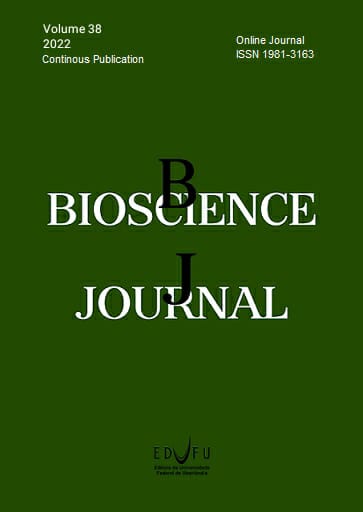Does amount of cut vegetal residue on the canopy influence growth and the structural characteristics of marandu palisadegrass?
DOI:
https://doi.org/10.14393/BJ-v38n0a2022-54109Keywords:
Brachiaria brizantha syn. Urochloa brizantha, Forage production, Morphological composition, Number of tiller, Urochloa brizantha.Abstract
The pasture mowing in late winter removes the old forage, improving the pasture structure in spring and summer. However, the residue after mowing can affect tillering, thus limiting forage production and the structural characteristics of pasture. We hypothesized that the high amount of cut vegetal residues on the plants in late winter causes a decrease in forage production and modifies the structural characteristics of the forage canopy during the spring and summer. The treatments were four cut vegetal residues (0; 2,000; 4,000 and 8,000 t ha-1 of natural material) deposited on Urochloa brizantha cv. Marandu canopy in late winter. After that, the forage production and structure characteristics were evaluated during the spring and summer for two years. The complete randomized block design, with four replications, was used. The defoliation management was characterized by the adoption of pre- and post-cut heights of 25 and 15 cm, respectively. For both years, there was no effect of cut vegetal residue on all the characteristics evaluated. No variable was affected by the interaction cut vegetal residue amount × year of evaluation. The dead leaf blade percentage was greater in year 2 (6.9%) than in year 1 (3.5%). The average values of variables were live leaf blade percentage = 84.2%; live stem percentage = 8.7%; dead stem percentage = 1.9%; number of vegetative tiller = 653 tiller/m2; number of reproductive tiller = 5 tiller m-2. The forage production rate presented an average value of 46 kg/ha/day of dry matter. The cut vegetal residue amount of up to 8,000 t/ha of natural material on the plants in late winter does not affect the forage production or modifies the structural characteristics of marandu palisadegrass during the subsequent spring and summer.
References
ALVARES, C.A., et al. Köppen’s climate classification map for Brazil. Meteorologische Zeitschrift. 2013, 22(6), 711-728. https://doi.org/10.1127/0941-2948/2013/0507
ARAÚJO, D.L.C., et al. Características morfogênicas, estruturais e padrões demográficos de perfilhos em pastagem de capim-andropógon sob diferentes ofertas de forragem. Semina: Ciências Agrárias. 2015, 36(5), 3303-3314. https://doi.org/10.5433/1679-0359.2015v36n5p3303
CANTARUTTI, R.B., et al. Recomendação para o uso de corretivos e fertilizantes em Minas Gerais. Viçosa: CFSEMG, 1999.
CARNEIRO, M.A.C., et al. Produção de fitomassa de diferentes espécies de cobertura e suas alterações na atividade microbiana de solo de Cerrado. Bragantia. 2008, 67(2), 455-462.
GIACOMINI, A.A., et al. Growth of marandu palisadegrass subjected to strategies of intermittent stocking. Scientia Agrícola. 2009, 66(6), 733-741. https://doi.org/10.1590/S0103-90162009000600003
MATTHEW, C., ASSUERO, S.G., BLACK, C.K. and SACKVILLE HAMILTON, N.R., 2000. Tiller dynamics of grazed swards. IN: LEMAIRE, G., HODGSON, J., MORAES, A. DE CARVALHO, P.C.F. and NABINGER, C. (Eds.). Grassland ecophysiology and grazing ecology. Curitiba: CABI, pp. 127-150. https://doi.org/10.1079/9780851994529.0127
PAIVA, A.J., et al. Morphogenesis on age categories of tillers in marandu palisadegrass. Scientia Agricola. 2011, 68(6), 626-631. https://doi.org/10.1590/S0103-90162011000600003
PEDREIRA, C.G.S., BRAGA, G.J. and PORTELA, J.N. Herbage accumulation, plant-part composition and nutritive value on grazed signal grass (Brachiaria decumbens) pastures in response to stubble height and rest period based on canopy light interception. Crop & Pasture Science. 2017, 68(1), 62–73. https://doi.org/10.1071/CP16333
SANTANA, S.S., et al. Initial height of pasture deferred and utilized in winter and tillering dynamics of signal grass during the following spring. Acta Scientiarum. Animal Sciences. 2014, 36(1), 17-23. https://doi.org/10.4025/actascianimsci.v36i1.20463
SANTOS, M.E.R., et al. Apparent selectivity of sheep in deferred marandu palisadegrass pastures with variable initial heights. Arquivo Brasileiro de Medicina Veterinária e Zootecnia. 2019, 71(5), 1727-1734. https://doi.org/10.1590/1678-4162-10750
SANTOS, P.M., CORSI, M. and PEDREIRA, C.G.S. Tiller cohort development and disgestibility in Tanzania guinea grass (Panicum maximum cv Tanzania) under three levels of grazing intensity. Tropical Grasslands. 2006, 40, 84-93.
SBRISSIA, A.F., et al. Tillering dynamics in palisadegrass swards continuously stocked by cattle. Plant Ecology. 2010, 206(2), 349-359. https://doi.org/10.1007/s11258-009-9647-7
SILVA, C.S., et al. Steer performance on deferred pastures of Brachiaria brizantha and Brachiaria decumbens. Ciência Rural. 2016, 46(11), 1998-2004. https://doi.org/10.1590/0103-8478cr20151525
SILVEIRA, M.C.T., et al. Forage sward structure of Mulato grass (Brachiaria hybrid ssp.) subjected to rotational stocking strategies. Australian Journal of Crop Science (Online). 2016, 10(6), 864-873. https://doi.org/10.21475/ajcs.2016.10.06.p7568
SOUSA, D.O.C., et al. Sheep production during the rainy season in marandu palisadegrass swards previously utilized under deferred grazing. Arquivo Brasileiro de Medicina Veterinaria e Zootecnia. 2018, 70, 1-8. https://doi.org/10.1590/1678-4162-9414
SOUZA, D.O.C., et al. A roçada do capim-marandu alto no fim do inverno melhora a estrutura do pasto no início do verão. Enciclopédia Biosfera. 2015, 11(21), 12-22.
TAIZ, L. and ZEIGER, E. Fisiologia vegetal. Porto Alegre: Artmed, 2013.
TRINDADE, J.K., et al. Composição morfológica da forragem consumida por bovinos de corte durante o rebaixamento do capim-marandu submetido a estratégias de pastejo rotativo. Pesquisa Agropecuária Brasileira. 2007, 42(6), 883-890. https://doi.org/10.1590/S0100-204X2007000600016
VALLE, C.B., et al., 2010. Gênero Brachiaria. In: FONSECA, D.M. and MARTUSCELLO, J.A. (Eds.). Plantas Forrageiras. Viçosa: Editora UFV, pp. 30-77.
Downloads
Published
Issue
Section
License
Copyright (c) 2022 Gabriella Fernandes Silva, Weisler Borges Fernandes, Gabriel de Oliveira Rocha, Flávia de Oliveira Scarpino van Cleef, Bruno Humberto Rezende Carvalho, Manoel Eduardo Rozalino Santos

This work is licensed under a Creative Commons Attribution 4.0 International License.





